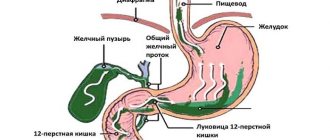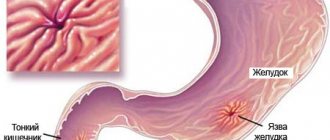Gastric atony is a disease in which the tone of the smooth muscle muscles of the stomach decreases and the activity of peristalsis decreases, which is popularly called “the stomach is up.” A consultation with a gastroenterologist will help you take adequate measures on what and how to do in such a situation at home.
This condition often develops in thin, asthenic people who constantly limit themselves in nutrition, or, conversely, in individuals prone to constant overeating. Unpleasant sensations in the form of heaviness in the abdomen, belching, and a specific smell from the mouth are all signs of a weak stomach.
Risk factors and causes of atony development
There are a number of provoking factors for the development of this disease, namely:
- Poor nutrition. Excessive restriction in food, in particular protein foods, or frequent consumption of fast foods leads to a lack of nutrients, microelements and vitamins. This depletes the force of peristaltic contractions and contributes to insufficient processing of food in the stomach by gastric juice, as a result of which the entire gastrointestinal tract “stands up”.
- Prolonged stressful situations. Stress leads to activation of the sympathetic nervous system, which is closely related to the regulation of peristaltic activity in the upper gastrointestinal tract. This is why a spasm of the stomach muscles occurs as a response to the secreted adrenaline, which contributes to the stagnation of gastric contents.
- Effect of anesthesia. If you have recently found yourself in a situation where you required surgery under general anesthesia, then a situation where the entire gastrointestinal tract will collapse is a very likely scenario. The drugs used for anesthesia relax all the smooth muscles and the gastrointestinal tract stops.
- Bad habits. Smoking, alcohol and caffeine affect the circulatory system, reducing the lumen of blood vessels and thereby providing less blood flow to the organs than required.
- Psychological factor. This applies to a greater extent to children during “critical periods” - weaning from breastfeeding, pacifiers, teething.
There are also several diseases that can lead to stomach failure:
- Myocardial infarction (even in history).
- Peritonitis.
- Pneumonia.
- Vascular thrombosis in the gastric wall.
- Surgical interventions on the gastrointestinal tract.
- Anorexia or obesity.
- Infectious diseases (Lyme disease, botulism, typhoid fever).
- Pathology of the central nervous system and endocrine system.
Clinical picture
This disease is easily diagnosed, mainly because the patient does not keep himself waiting and soon appears at the gastroenterologist’s appointment. The complaints made by patients are as follows:
- Abdominal pain, a feeling of heaviness and pressure in the epigastric region, a feeling of fullness in the stomach.
- Nausea, heartburn, belching, bad breath.
- There may be vomiting with pieces of food, which brings relief to the patient.
- Pale skin, cyanosis of mucous membranes, cold sticky sweat.
- Increased heart rate and low blood pressure.
When examined by a doctor, a number of specific symptoms are revealed - a splashing noise during palpation (indicates stagnant liquid food in the stomach), a “drum” sound is heard when percussing the stomach area (indicates air collected in the upper section). When probing the stomach, the contents of the stomach come out quite easily, after which the patient feels much better. This procedure is sometimes an emergency aid in these situations.
What to do if your stomach suddenly stops: determining the cause
Impairment in the functioning of the organ may occur for the following reasons:
- Organ prolapse;
- Overwork;
- Violation of the innervation of the organ due to pathologies of the nervous system;
- Fast weight loss;
- Binge eating;
- Abuse of fatty and spicy foods;
- Smoking;
- Past illnesses that led to exhaustion. A great danger in this situation is posed by illnesses of infectious etiology: dysentery, pneumonia, influenza, typhoid fever;
- Acute diseases of the abdominal organs located nearby;
- Operations on the abdominal organs or surgical interventions performed under general anesthesia.
Gastric failure in a child can be triggered by psychological factors, for example, potty training, weaning, changes in the family situation, etc.
It should be noted that people with an asthenic build, those who are physically underdeveloped, and those who are constantly exposed to nervous stress are more prone to atony.
Symptoms and signs of gastric arrest
When an organ stops working, the following sensations appear:
- Sharp or dull pain in the abdomen;
- A feeling of fullness occurs even after eating a minimal amount of food. Nausea when overeating;
- Bad breath;
- Heaviness in the abdomen;
- Lack of appetite;
- Hiccups;
- Bloating, especially in the upper abdomen;
- Feeling that the stomach has become a stake;
- Sometimes shortness of breath occurs and the temperature rises.
Frequent nausea and stomach upset: diagnosis
The listed symptoms are accompanied not only by atony, but also by other gastrointestinal diseases, for example, organ prolapse, peptic ulcer, exacerbation of chronic gastritis. That is why differential diagnosis is necessary, which should be carried out by a gastroenterologist together with other highly specialized specialists.
To make a diagnosis, you need to undergo several studies, the main of which are radiography with contrast and fibrogastroscopy. In the first case, you need to drink an aqueous solution of barium - a contrast agent. The second study allows you to examine the internal surface of the organ using a special device, similar to a probe and equipped with optics.
The stomach has stopped: how to start it up: a set of measures
Solving the problem must be approached comprehensively. First, you need to be examined for pathology that could provoke this symptom.
If this is excluded, you can use the recommendations on how to start your stomach. Therapy includes diet therapy, exercise therapy, medication and a number of folk recipes.
Diet therapy
Diet correction is the basis of treatment. Only with this method can you regain your health without worsening your condition and ensuring the supply of nutrients to your body.
Treatment of atony through diet:
- Eat food in small portions - literally a few tablespoons per meal;
- The break between meals should be about an hour and a half;
- The volume of portions is increased gradually;
- Avoid foods that contribute to gas formation - sweets, legumes, carbonated drinks;
- Boiled eggs, pears and rice are completely excluded from the menu;
- It is recommended to consume food in crushed and liquid form.
Folk remedies for temporary stomach arrest
- You can start the gastrointestinal tract with the help of oregano. To do this, you will need to pour 10 g of oregano into a glass of boiling water and leave for 30 minutes. You need to drink it strained, 1 tsp each. Take the medicine in the mornings and evenings.
- You can also use other folk recipes, for example: mix 2 tbsp. l. the following components - marshmallow root, fennel seeds, buckthorn bark; pour 1 ½ cups of boiling water over a large spoonful of the mixture; put the medicine in a water bath and keep it there for a quarter of an hour, then leave for another 20 minutes; Strain the cooled broth. You need to take a glass of medicine after each meal.
- Before a meal, it is recommended to eat a teaspoon of dry milk thistle, washing it down with half a glass of water.
- What to do if your stomach has stopped, your stomach hurts and you feel sick: we use medications.
The same remedies as for nausea will help relieve the manifestations of atony. These stimulate the muscles, toning them and directing their movement from the esophagus to the duodenum.
Diagnostics
There are 2 main methods for diagnosing this disease - direct peripheral electrogastrography. In addition, fluoroscopy or radiography of the stomach and esophagogastroduodenoscopy (EGD) will help.
Electrogastrography is used to study the motor-evacuation function of the stomach. The method is based on recording its electrical activity.
Before taking an x-ray, the patient is asked to drink a glass of barium suspension; thanks to contrast, the outline of the stomach can be seen, and its condition will confirm the disease. With atony, the shape becomes elongated, with a drooping bottom and the appearance of a “waist.” The passage of the contrast agent is slowed down, and residues can be observed even 6 hours after the start of the study.
During EGD, an endoscope with video optics is inserted through the oral cavity, where you can see the expanded stomach cavity with the remains of undigested food.
Peristalsis during atony is significantly reduced all the way to the intestines, up to paresis of smooth muscle muscles.
Treatment
The list of therapeutic measures for gastric atony includes placing a gastric tube to evacuate all contents, prescribing a therapeutic diet (table No. 2) and taking medications that will restore gastrointestinal motility and help “start up” the gastrointestinal tract: prokinetics (Itopride, Metoproclamide), enzymes (Pancreatin, Mezim, Panzinorm) and vitamins. In severe forms, anabolic steroids and drugs with regenerating properties are added.
How to understand that the stomach has “stood up”?
The main signs of the pathology, scientifically called atony, are severe heaviness felt in the area where the organ is located, bloating, and vomiting.
Unfortunately, such a pathology can be observed not only in an adult, but even in a small child, since the reasons that provoke it are not always hidden in poor eating behavior, alcohol abuse or smoking.
The main feature that characterizes gastric atony is reduced peristalsis of its walls.
The motor function of this organ is responsible for the organization of peristaltic processes, which ideally should work like a clock and become active immediately after the food eaten by a person passes from his esophagus to his stomach.
To understand how the motor function of the stomach works and what to do with atony, you should learn more about the structure of this organ.
The stomach is conventionally divided into four parts:
- cardia, located at the junction of the organ with the esophagus;
- the bottom, localized in its lateral part;
- the body serving as the main reservoir for the primary processing of food by gastric juice;
- the pylorus, located in the area of contact of this organ with the small intestine.
The peristaltic activity of the stomach is activated in the area of the pylorus, located between the body of the organ and the pylorus.
Any person who pays attention to their health and has general information about the work of internal organs knows that the stomach can contract and expand, increasing in size.
READ What do dull pains in the stomach indicate?
These processes are carried out thanks to three types of muscles located between the mucous membrane of this organ and its serous membrane.
The motor function of the stomach is realized through alternating contractions of circular muscle fibers, which seem to “squeeze” food, forcing it to move down towards the intestinal system through the pylorus.
What to do when your stomach stops? First, find out what caused the spasm of the circular muscle fibers.
Symptoms characteristic of atony (heaviness in the abdomen, vomiting, lack of appetite) appear due to the fact that the food bolus, which has been exposed to hydrochloric acid, cannot move further along the digestive tract and remains inside the organ for a long time, presses on its walls and begins to decompose .
What to do in such a situation? How to “start” the work of the stomach at home? Is it possible to take any medications and forget about the problem? The following paragraphs of the article will tell you about this and some other things.
Emergency help at home
When the first symptoms from the above list appear, you can use enzymes (Mezim, Pancreatin), which know how to make the stomach work without harming it. As a rule, 1 tablet is enough to provide relief within 20 minutes. However, taking enzyme preparations is contraindicated during exacerbation of pancreatitis. For nausea, use absorbents (activated carbon) to relieve discomfort. You can provoke vomiting by drinking 1.5-2 liters of cool water; getting rid of “stagnant” food will greatly improve the patient’s condition.
Traditional methods of treating the stomach
Folk remedies will help quickly establish the full functionality of the organ. They not only make the stomach work, but also remove toxins and have an anti-inflammatory effect on the body.
- Cinnamon. Cinnamon will help improve your condition. To do this, you need to get up early in the morning and prepare a drink from a mug of warm water and a spoon of cinnamon. Everything is thoroughly mixed. The drink is taken on an empty stomach. You can eat after 30-40 minutes.
- Fennel. A decoction based on fennel has the desired effect. It is usually used to treat colic in children and increased gas formation. To prepare the drink, take buckthorn, marshmallow root and fennel in equal proportions. Everything is poured into a mug of boiled water and brought to a boil on the stove. The medicine needs to infuse for about an hour. Then strain and take for breakfast and dinner.
- Milk thistle. Milk thistle seeds help with swallowing problems and stomach problems. You can purchase the product at a pharmacy or specialized nutrition store. You should take milk thistle up to 5-6 times a day, one teaspoon. After the disappearance of unpleasant symptoms, the plant is taken one spoon 2-3 times a day.
- Baking soda. This method helps in reducing acidity and normalizing hydrochloric acid levels. But it should not be abused, otherwise the effect will be the opposite. Half a teaspoon of baking soda is added to a mug of warm water. Mix thoroughly until completely dissolved. Take after meals. After some time, the patient will belch, but the stomach will stop hurting.
First aid for a child
If the child is worried about nausea, then you need to artificially induce vomiting using the above method. Give your baby a comfortable position: lay him on his side, bend his knees and hips, place your hand on his stomach and wait until the symptoms subside and the baby falls asleep.
The next day, any food is excluded from the diet; sweet tea and homemade crackers without additives or seasonings are allowed.
If the symptoms do not stop, you should not prescribe medications yourself; consult a pediatrician.











